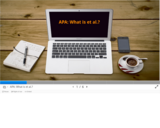
In this learning object, students will learn what et al. means and how to use it in an APA in-text citation.
- Subject:
- Composition and Rhetoric
- English Language Arts
- Material Type:
- Interactive
- Provider:
- Michigan Virtual
- Date Added:
- 03/15/2022

In this learning object, students will learn what et al. means and how to use it in an APA in-text citation.

In this unit students continue the exploration of factors that influence change by examining the events that led up to the American Revolution. Over the course of the unit, students will build a deeper understanding of the significant ideas and values at the heart of the American Revolution, what drove the colonists to seek independence, and how conflict between England and the colonists ultimately influenced change in our country. Students will see the American Revolution from multiple perspectives, starting with analyzing the difference in perspectives between the British and the colonists and how each side’s actions often instigated each other. Students will also explore how class structure influenced colonists perspectives. Later in the unit, students will think about the perspectives of black people, women and Native Americans who were forced to choose a side and why they may have had a different point of view of the events of the revolution.
An important part of this unit is pushing students to focus on seeing history from multiple different perspectives. The core text Liberty! How the Revolutionary War Began offers one perspective on events, however, the prespective is limited to that held by white elite colonists. Therefore, students also read excerpts from A Young People's History of the United States in order to build a deeper understanding of all sides of the Revolution.
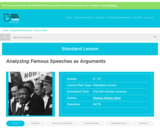
Students are often asked to perform speeches, but rarely do we require students to analyze speeches as carefully as we study works of literature. In this unit, students are required to identify the rhetorical strategies in a famous speech and the specific purpose for each chosen device. They will write an essay about its effectiveness and why it is still famous after all these years.
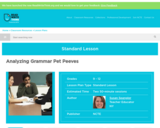
By analyzing Dear Abby's rant about bad grammar usage, students become aware that attitudes about race, social class, moral and ethical character, and "proper" language use are intertwined.

In this unit students explore the rise and fall of the ancient Roman Empire. Over the course of the unit, students learn about different characteristics of the Roman Empire, what lead to the Empire’s growth and success, and what eventually lead to the Empire’s demise. Through learning about the daily routines, structures, and rituals of the Roman Empire, students will be challenged to draw conclusions about what the civilization valued and how those values compare to societal values today. This unit builds onto the 2nd grade nonfiction unit on ancient Greece, in which students began to think about how the daily routines, structures, and rituals of a civilization show what they value. This unit, in conjunction with the second grade unit on ancient Greece, will help students understand early influences in the world and the first republics.
The mentor texts for this unit, Ancient Rome and Pompeii: A Nonfiction Companion to Magic Tree House and Eye Wonder: Ancient Rome, allow students to practice multiple informational reading strategies in two very different text structures. In both texts, but predominately in Eye Wonder, students will practice using a multitude of text features and illustrations as a way of learning new information about a topic. Over the course of this unit, students will constantly be thinking about how the information from one text builds on and connects to the information in the other text. Then at the end of the unit, students will be asked to critically analyze the similarities and differences between the two texts.

LEARNING TO WRITE BIOGRAPHIES
Discuss biographies previously read
Students will write a biography about one of the people they have read about. They will use information from one of these books and information from an online source to plan and write the biography.
Review Writing Process
Create Graphic Organizer model
Informative Writing Checklist
Students will work in their research groups and choose 3-4 subtopics. Then students will begin the graphic organizer.
Sharing
Use the Smartboard or projector to display www.factmonster.com.
Students will continue to work in their research group. They need to complete their research from the class book quickly and begin their search with source two.
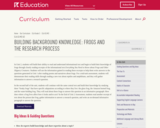
In Unit 2, students will build their ability to read and understand informational text and begin to build their knowledge of frogs through closely reading excerpts of the informational text Everything You Need to Know about Frogs and Other Slippery Creatures. Students will use the information gained in reading these excerpts to help them write answers to the questions generated in Unit 1 after reading poems and narratives about frogs. For a mid-unit assessment, students will demonstrate their reading skills through reading a new text about reptiles and amphibians, and they will gather information to answer a research question.
In the second half of the unit, students will continue with the same central text and build their knowledge by studying three "freaky frogs" that have specific adaptations according to where they live: the glass frog, the Amazon horned frog, and the water-holding frog. They will read about these frogs to answer this question in an informative paragraph: How does where a frog lives affect how it looks and/or acts? In the End of Unit 2 Assessment, students read another excerpt of text about the poison dart frog, gather information to answer a research question, and write an on-demand informative paragraph to answer the question.
RI.3.1, RI.3.3, RI.3.4, RI.3.5, RI.3.7, RI.3.8, W.3.2, W.3.7, W.3.8, L.3.1d,e, L.3.4

In this first unit of second grade, students read multiple versions of a classic fairy tale, Cinderella. Through reading various versions of the same story, students are not only exposed to a wide variety of cultures, but they are also challenged to think about how the culture, or setting, of the story influences the plot. In first grade fiction, students took a trip around the world, exploring a wide variety of themes and stories from all over, in order to build a foundational understanding that our world is made up of many diverse and unique cultures. This unit builds on the exposure to new cultures students received in first grade and provides an opportunity for students to explore the idea that even though cultures may appear to be different, there are many things embedded within the unique characteristics of different cultures that make them similar. Storytelling, and the role of storytelling, is one of those similarities. It is our hope that this unit, in connection with others in the sequence, helps students build empathy and understanding of the world around them.
The different versions of Cinderella help students understand the components of a fairy tale and the lessons associated with traditional fairy tales. Over the course of the unit, students will be challenged to ask and answer questions about the text and illustrations as a way of deepening their understanding of plot, setting, and characters. In the first section of the unit, students will focus deeply on the setting, characters, and plot of the different versions of Cinderella, learning to compare and contrast the nuances across different versions. In the second section of the unit, students will read Cinderella stories that vary from the traditional plot structure but still include the underlying theme that a person’s actions (good or bad) influence his/her life outcomes. In this section students will dive deeply into three texts to analyze different characters’ traits and how the author uses those traits to help reveal the lesson of the story.
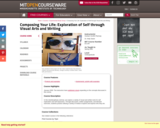
In this interdisciplinary seminar, we explore a variety of visual and written tools for self exploration and self expression. Through discussion, written assignments, and directed exercises, students practice utilizing a variety of media to explore and express who they are.

Week 36, Day 1---Day 5
Culminating Activity: Reading and Writing Identity
Memoir: Special memories about a person, place, object or time
"The memoir you will be writing will be a reflection of how you have changed as a reader and writer this year. It’s going to be like a year in review, so you will create a mini book as part of the memoir project.
Some of you may be thinking that this is the same as a personal narrative, but memoirs are more about looking back and thinking about how things have changed over time just like we did at the beginning of class. Narratives tell a story, but memoirs show how the event was meaningful to the author’s life. Also, memoirs are only snapshots. They don’t include the person’s whole life. Now I will add the characteristics of memoirs to the chart.
Use 1st person
Use true descriptions of actual events
Describe any problems faced by the author
Include the author’s feelings about the situation or event
*Narrative Graphic Organizer
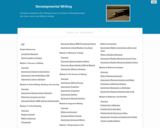
This course introduces students to the writing process as a means of developing ideas into clear, correct, and effective writing.

Educators worked with coaches to create Lesson Plans promoting both content area and digital age skills. This Lesson Plan is designed for Grades 6-8 English Language Arts.
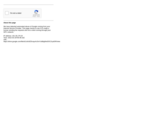
Students will learn the potential costs and benefits of social media, digital consumption, and our relationship with technology as a society in the three-week lesson. This inquiry based unit of study will answer the following questions:
Essential Question: How can we use science fiction’s ability to predict the future to help humanity?
Supportive Questions 1: What predictions of future development has science fiction accurately made in the past? This can include technology, privacy, medicine, social justice, political, environmental, education, and economic.
Supportive Question 2: What predictions for future development in contemporary science fiction are positive for the future of humanity? What factors need to begin in your lifetime to make these predictions reality?
Supportive Question 3: What predictions for future development in contemporary science fiction are negative for the future of humanity? What factors need to begin in your lifetime to stop these negative outcomes?

In this science-based unit, students explore the world of energy. In the first half of the unit students learn what energy is, the different ways that energy is transferred from place to place, and the ways energy can be converted from one type to another. In the second half of the unit students explore the pros and cons of different types of renewable and nonrenewable energy. After learning about the different types of energy, students will grapple with what the world’s energy future will look like if more renewable solutions aren’t found, particularly in their communities. Through a combination of reading and research, it is our hope that students begin to build a deeper understanding of energy and its influence on our lives.
This unit builds on to the informational reading skills and strategies developed in previous units. At this point in the year we assume that students are able to actively read and annotate informational texts in order to build understanding of a topic. Therefore, the focus of this unit is on refining students’ ability to use different strategies to comprehend denser scientific texts. In particular, students will continue working on determining the main idea, summarizing key details, explaining cause and effect, using text features to improve understanding, and explaining how an author uses text features to elaborate on key concepts and ideas.
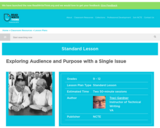
Students explore the concepts of audience and purpose by focusing on an issue that divided Americans in 1925, the debate of evolution versus creationism raised by the Scopes Monkey Trial.

In this unit students explore immigration by reading a series of narrative nonfiction and fiction texts that highlight the experiences of early and recent immigrants. In the first part of the unit students are pushed to notice and think about the different reasons people choose to leave their homes and settle in a new community or country. Students will then be pushed to think about the different memories, cultural traits, goods, ideas, languages, and skills that individuals and families bring with them when they move to a new place and how these characteristics enrich the community. While students are exposed to a wide variety of immigrant experiences over the course of the unit, not every experience or feeling about immigration is captured in this unit. Because many of our students are first- or second-generation immigrants, it is crucial to be sensitive to and respect the varying experiences and feelings of our students and families. It is our hope that this unit, in connection with others, will help students build sensitivity and empathy for varying cultures and experiences within the United States.

In this unit, students study the rovers Spirit and Opportunity and their remarkable missions to Mars. Through a combination of reading, analyzing images and photographs, and participating in engineering and design labs, students will begin to understand the complexity, preparation, and diligence involved in space missions. Students will grapple with why the engineering and design process, particularly continually planning, trying, and evaluating, is a crucial part of a successful mission. This unit also allows students to make connections between content learned in math and content learned in previous science units, solidifying the importance and value of STEM. It is our hope that this unit inspires students to explore engineering and STEM not only in space but in the world around them.
In this unit, students build their skills in consuming scientific and technical texts. Students will practice explaining the connection between two or more scientific ideas or concepts in a text. Additionally, students will be challenged to draw on and integrate information from two or more texts in order to describe a scientific idea, concept, or process in depth. This unit also continues the study of point of view and analyzing how the point of view influences what and how information is presented to a reader. The Mighty Mars Rover is written to captivate and engage a reader, while the NASA press releases are written to inform the public of the progress and findings of the Mars rover missions. Students will be challenged to compare and contrast the point of view of each text and the strategies each author uses based on the point of view and desired audience. Since this is the culminating unit of the course, all other informational standards will be spiraled throughout the unit.

Formulating, organizing, and presenting ideas clearly in writing. Reviews basic principles of rhetoric. Focuses on development of a topic, thesis, choice of appropriate vocabulary, and sentence structure to achieve purpose. Develops idiomatic prose style. Gives attention to grammar and vocabulary usage. Special focus on strengthening skills of bilingual students. Successful completion satisfies Phase I of the Writing Requirement. The purpose of this course is to develop your writing skills so that you can feel confident writing the essays, term papers, reports, and exams you will have to produce during your career here at MIT. We will read and analyze samples of expository writing, do some work on vocabulary development, and concentrate on developing your ability to write clear, accurate, sophisticated prose. We will also deal with the grammar and mechanical problems you may have trouble with.

In this unit students study the Civil Rights Movement through the eyes of the youth and children who experienced the struggles, hardships, victories, defeats, and possibilities firsthand. Students will be challenged to analyze the key characteristics shared by children who participated in the Civil Rights Movement, particularly their courage, commitment, bravery, and unending commitment to fighting for the cause. Over the course of the unit students will realize that through community organizing and a strong desire for justice, regular people, especially youth, were able to come together to use a variety of nonviolent tactics to fight for change, even when faced with resistance, oppression, and violence on a daily basis. The stories and experiences in the unit will highlight that the Civil Rights Movement was driven by the heroism of regular people and that anyone can participate in the fight against injustice. It is our hope that this unit, in conjunction with other units from the sequence, will empower students to notice and challenge the injustices, relying on their knowledge of history and the lessons they’ve learned from those who have fought before them.
In this unit students refine their skills as critical consumers of texts by analyzing the point of view from which a text is written and noticing how the point of view influences what and how information is presented to a reader. Students will read multiple accounts of the same topic or event and be challenged to notice the similarities and differences in the points of view they represent and how the author uses evidence and reasons to support a particular point of view. Photographs are an important part of the texts in the unit. Students will be pushed to analyze photographs as a source of information to support an author’s point. Students will also continue to practice determining one or more main ideas of a text and explaining how they are supported by key details, summarizing a text, and explaining the relationship between one or more events or individuals in a historical text. Over the course of the unit students will also be required to access information from multiple sources in order to integrate information and draw conclusions about an event or topic.

This unit serves as a foundation for understanding the way in which the American government was formed and the way it is structured. The unit has three main sections. In the first section, students learn about the functions of government, the three main branches of government, and how the branches work together to meet the ever-changing needs of our country. In this section students will be challenged to think about how government is useful to its citizens and about the key powers of each branch. In the second section, students explore elections and how people become elected officials. Students also explore the women's suffrage movement, why women couldn't vote before 1920, and what changes brought about women's suffrage in the United States. Finally, in the third section, students read biographies of a few courageous individuals who overcame racism, sexism, and hardships to prove that they deserved a spot in government and that they would do whatever it takes to fight for and push for change. During this final section, students will be challenged to think about how the actions of others can inspire us to drive for change, especially in the current political climate.
This unit expands on the work done in units 1 and 2 to build reading skills. Students will continue to develop their skills as critical consumers of a text by annotating for main idea and details that support the main idea of a text, summarizing sections of a text, explaining the connection between ideas and concepts, interpreting information presented through different text features, and describing the structure of different paragraphs. In this unit students will also be challenged to think about how an author uses evidence and reasoning to support particular points or ideas in a text. They will also be challenged to integrate information from one text with information they learn in another text about the same topic.